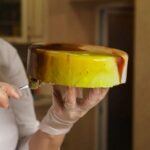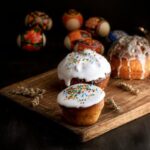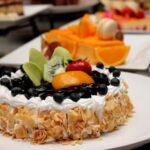Chocolate panels are a versatile and impressive way to add a touch of elegance and creativity to your cake decorating. In this article, we will guide you through the process of making chocolate panels for cake decorating. From choosing the right chocolate to troubleshooting common issues, we will cover everything you need to know to master this technique.
When it comes to creating chocolate panels for cake decorating, the type of chocolate you use plays a crucial role in the final result. Whether you prefer dark, milk, or white chocolate, selecting high-quality chocolate is essential for achieving smooth and glossy panels. By following our step-by-step instructions, you’ll learn how to properly prepare the chocolate for molding and create stunning designs that will elevate your cakes to the next level.
With endless possibilities for customization, chocolate panels allow you to unleash your creativity and experiment with different shapes and designs. From geometric patterns to floral motifs, the only limit is your imagination. Discover how adding color can enhance the visual appeal of your chocolate panels and learn techniques for attaching them seamlessly to your cakes. Stay tuned for expert tips on storing and preserving your beautiful creations for future use.
Choosing the Right Chocolate for Your Panels
When it comes to making chocolate panels for cake decorating, selecting the right type of chocolate is key to achieving the desired results. The type of chocolate you choose will affect not only the taste but also the texture and workability of your panels. Dark, milk, or white chocolate can be used depending on your preference and the design you have in mind.
Couverture Chocolate vs. Candy Melts
One important decision to make is whether to use couverture chocolate or candy melts for your panels. Couverture chocolate contains a higher percentage of cocoa butter compared to regular chocolate, giving it a smoother texture and better shine when set. Candy melts, on the other hand, are specifically designed for confectionery purposes and come in a variety of colors, making them ideal for adding vibrant hues to your panels.
Quality and Flavor Consideration
Consider the quality of the chocolate you choose as it will greatly impact the overall taste of your cake. Opt for high-quality chocolate with a rich flavor profile for a more decadent experience. Additionally, take into account any dietary restrictions or preferences such as vegan or gluten-free options when selecting your chocolate.
Melting and Tempering Chocolate
Properly melting and tempering chocolate is crucial for successful panel making. Whether you choose to melt your chocolate in a double boiler or microwave, ensure that it is done gradually and gently to prevent overheating and seizing. Tempering the chocolate by heating and cooling it properly will result in a shiny finish and good stability for intricate designs on your cake decorations.
Preparing the Chocolate for Molding
Tempering the Chocolate
One of the essential steps in preparing chocolate for molding into panels is tempering. Tempering involves heating and cooling the chocolate to specific temperatures to ensure a glossy finish, smooth texture, and proper setting.
To temper chocolate, you can use the seeding method by adding small pieces of unmelted chocolate to melted chocolate or use a double boiler for more precise temperature control. Properly tempered chocolate will result in sturdy panels that are easy to work with and have a professional-looking sheen.
Melting Techniques
When melting chocolate for panels, it is crucial to do so gently and evenly to prevent burning or seizing. You can melt the chocolate in a microwave-safe bowl at short intervals, stirring in between each session until smooth.
Alternatively, you can melt the chocolate over a double boiler, making sure not to let any water come into contact with the chocolate. Once melted, allow the chocolate to cool slightly before pouring it into molds or spreading it onto acetate sheets for creating panels.
Adding Flavor and Enhancements
To infuse your chocolate panels with additional flavor, you can mix in extracts like vanilla or almond, spices such as cinnamon or chili powder, or liqueurs like Grand Marnier or Kahlua. Adding these elements can elevate the taste profile of your cake while still maintaining the integrity of the chocolate base.
You can also consider incorporating mix-ins like crushed nuts, dried fruit, or edible flowers for added texture and visual interest. Experimenting with different flavors and enhancements can make your chocolate panels truly unique and delicious additions to your cake decorating projects.
Creating Different Designs and Shapes With Chocolate Panels
Chocolate panels are a versatile and elegant way to add dimension and texture to your cake designs. With chocolate panels, you can create intricate patterns, unique shapes, and eye-catching decorations that will impress your guests. Whether you’re looking to add a touch of sophistication or a pop of color to your cakes, knowing how to make chocolate panels for cake decorating is a skill worth mastering.
When creating chocolate panels for cake decorating, one of the most exciting parts is experimenting with different designs and shapes. The possibilities are endless, from classic geometric patterns to whimsical floral motifs. Here are some ideas to spark your creativity:
- Stripes: Create bold and modern designs by layering alternating colors of chocolate to achieve striped patterns.
- Lace: Mimic the delicate look of lace by piping intricate designs onto acetate sheets and letting them set before transferring them onto your cake.
- Marble: Swirl different colors of chocolate together to create a marble effect that adds elegance and visual interest to your cake.
In addition to these ideas, you can also use cookie cutters or stencils to create specific shapes like hearts, stars, or even animals. By mixing and matching these techniques, you can customize your chocolate panels to suit any theme or occasion. Experiment with different textures, colors, and sizes to see what works best for your cake decorating vision.
Adding Color to Your Chocolate Panels
When it comes to cake decorating, chocolate panels can be a fantastic way to add a touch of elegance and creativity to your creations. In this section, we will explore how to add color to your chocolate panels, allowing you to customize them to fit any theme or design.
One popular method for adding color to chocolate panels is by using gel food coloring. Simply melt your chocolate as usual, and then mix in a small amount of gel food coloring until you achieve your desired shade. Be sure to work quickly, as chocolate can harden fast once it cools down. You can also use cocoa butter-based colors specifically designed for use with chocolate, which can provide more vibrant and consistent results.
Another way to incorporate color into your chocolate panels is by using colored cocoa butter. Simply melt the colored cocoa butter and brush or drizzle it onto the surface of your molded chocolate before it sets. This method allows for more precise control over where the color goes and can create beautiful marbled effects on your panels. Experiment with different techniques such as splattering or painting with a brush to achieve unique designs.
Attaching Chocolate Panels to Your Cake
When it comes to adding those beautiful chocolate panels to your cake, proper attachment is key to ensure they stay in place and enhance the overall look of your creation. One popular method for attaching chocolate panels to a cake is by using a thin layer of melted chocolate or ganache as “glue.” This helps the panels adhere securely while also blending seamlessly with the rest of your design.
To begin, make sure that the surface of your cake is clean and ready for the chocolate panels. Carefully measure and cut your panels to fit the sides or top of your cake, depending on your desired design. Once you have your panels ready, gently brush a small amount of melted chocolate along the edges that will come into contact with the cake. Press the panel onto the cake firmly but gently, making sure it sticks in place.
Another technique for attaching chocolate panels involves using edible glue or royal icing. These options provide a strong hold and are especially useful if you need to attach intricate or delicate designs to your cake. Simply apply a small amount of edible glue or royal icing along the back of the panel before carefully positioning it on the cake surface. Allow some time for it to set and dry completely before moving or handling the cake further.
| Proper Attachment Techniques | Benefits |
|---|---|
| Using melted chocolate/ganache as “glue” | Blends seamlessly with design and provides a secure hold |
| Edible glue or royal icing | Ideal for intricate designs, strong hold, and easy application |
Troubleshooting Common Issues With Chocolate Panels
When it comes to creating chocolate panels for cake decorating, there can be a few common issues that you may encounter along the way. One of the most frequent problems is that the chocolate panels crack or break easily. This can happen if the chocolate is not properly tempered before molding. To avoid this issue, make sure to follow the tempering process diligently and allow the chocolate to cool and set correctly.
Another common problem when working with chocolate panels is that they may not release from the molds easily, leading to deformed or incomplete shapes. To prevent this, ensure that you properly grease or line your molds before pouring in the melted chocolate. Additionally, letting the chocolate set for the right amount of time before attempting to remove them can also help in achieving clean and intact panels.
Lastly, some decorators might find that their chocolate panels have a dull finish instead of a shiny one. This could be due to improper melting techniques or using low-quality chocolate. To get that glossy look on your panels, melt your chocolate gently using a double boiler or microwave at short intervals while stirring consistently. Choosing high-quality chocolate with a good cocoa content will also contribute to achieving a beautiful shine on your finished panels.
| Common Issue | Troubleshooting Tip |
|---|---|
| Chocolate cracking or breaking easily | Properly temper the chocolate before molding |
| Difficulty releasing from molds | Grease or line molds before pouring in melted chocolate and allow proper setting time |
| Dull finish on panels | Melt chocolate gently and use high-quality chocolate for a glossy finish |
Tips for Storing and Preserving Chocolate Panels
Storing and preserving chocolate panels is crucial to ensure that they maintain their shape, flavor, and texture until you are ready to use them in your cake decorating project. Proper storage will also help prevent any unwanted changes in the appearance of your chocolate panels. Here are some tips to help you store and preserve your chocolate panels effectively.
After creating your chocolate panels, make sure they are completely set and hardened before storing them. You can do this by placing them in the refrigerator for a few hours or letting them sit at room temperature for a longer period of time. Once they are ready, carefully remove the chocolate panels from their molds and place them on a flat surface lined with parchment paper or wax paper.
To store your chocolate panels, place them in an airtight container or resealable plastic bag. Make sure to layer the panels between sheets of parchment paper to prevent them from sticking together or getting damaged during storage. Store the container in a cool, dry place away from direct sunlight and moisture. Avoid storing your chocolate panels in the refrigerator or freezer for extended periods as this can cause discoloration and affect the texture of the chocolate.
When ready to use your stored chocolate panels, allow them to come to room temperature before handling them. This will help prevent any condensation from forming on the surface of the chocolate which could ruin their appearance. By following these tips for storing and preserving your chocolate panels, you can ensure that they remain fresh and beautiful until you are ready to showcase them on your cake for a stunning presentation.
Inspiration and Ideas for Using Chocolate Panels in Cake Decorating
In conclusion, learning how to make chocolate panels for cake decorating opens up a world of endless possibilities in terms of creativity and design. By mastering the art of creating these panels, you can elevate the look of your cakes and desserts to a professional level. Whether you are a beginner or a seasoned baker, experimenting with different designs, shapes, and colors will allow you to customize your creations according to any theme or occasion.
One of the key aspects of using chocolate panels in cake decorating is the ability to showcase your unique style and personality through your creations. From geometric patterns to intricate floral designs, the only limit is your imagination. With the right tools and techniques, you can easily create stunning masterpieces that will leave your guests in awe.
Lastly, don’t be afraid to push the boundaries and try new techniques when working with chocolate panels. Experiment with different textures, flavors, and shapes to add a personal touch to your cakes.
Remember that practice makes perfect, so don’t get discouraged if your first attempts are not flawless. With time and dedication, you will become more confident in your skills and be able to create beautiful works of edible art that will delight both the eyes and taste buds of those lucky enough to enjoy them.
Frequently Asked Questions
How to Make Chocolate for Cake Decorating?
Making chocolate for cake decorating involves melting chocolate chips or bars in a double boiler or microwave, then pouring the melted chocolate into molds to create various shapes and designs. Once the chocolate sets, it can be used to adorn cakes with beautiful decorations.
How to Make Thin Strips of Chocolate?
To make thin strips of chocolate, start by tempering the chocolate to ensure that it has a shiny finish and snaps cleanly when broken. Then, spread the tempered chocolate thinly on a sheet of parchment paper using an offset spatula. Let it set partially before cutting the chocolate into thin strips using a sharp knife.
How to Make Chocolate Tiles?
Creating chocolate tiles is a fun and versatile way to decorate desserts like cakes and cupcakes. To make chocolate tiles, simply pour melted and tempered chocolate onto a smooth surface like a baking sheet lined with parchment paper.
Use an offset spatula to spread the chocolate evenly before letting it set completely. Once set, carefully cut the hardened chocolate into square or rectangular tiles using a sharp knife for a professional-looking finish on your desserts.

Welcome to my blog about home and family. This blog is a place where I will share my thoughts, ideas, and experiences related to these important topics. I am a stay-at-home mom with two young children. I hope you enjoy reading it! and may find some helpful tips and ideas that will make your home and family life even better!





